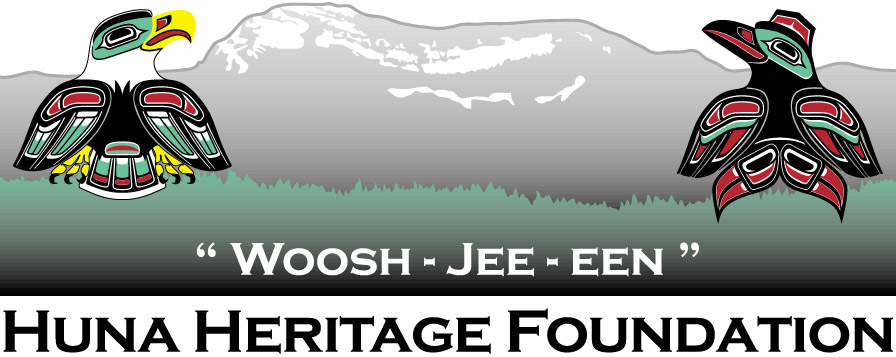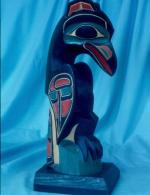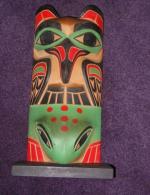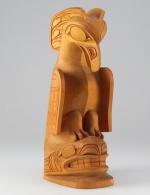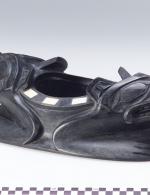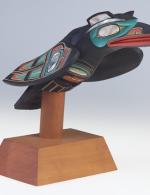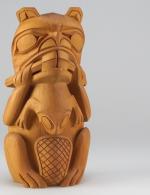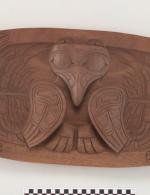Hoonah Master Carver and Artist David Williams with Some of his Carvings
David John Williams
Tlingit Name: Kowdooxgoosh
He was Tlingit, Eagle moiety, Chookaneidi clan, Brown Bear House.
It is true behind every strong man is a strong, supportive woman. Marrying my mother Mamie Johanna (Martin) Williams, she was a good listener, of great encouragement and strong support to my father.
With our father’s limited education, our mother helped him, and dad listened to her. She made him more educated, made him more eloquent with his letters and communication about his art. They made a great team. Mom had always said they became one mind throughout their married life. He was a man of many talents; boat builder, carpenter, musician, building designer and master wood carver. With only a third-grade education he learned all that he can and whatever was needed to learn to achieve what his life needed. To him the doors where wide open.
In later years he did wood sculpture with work represented in the Smithsonian Institute in Washington, DC. He spent a month in London, England in 1971 giving demonstrations at an international art exhibit. He spoke of having lunches with Queen Elizabeth for two weeks; conversing that each of his pieces having a story behind it. He wanted a hamburger, not knowing what it was called he described it and was given a different meal. Then one day he said I will try a Whimpee, which turned out to be the cheeseburger he described and wanted. His stories of his visits with Queen Elizabeth was endless and enjoyable to hear.
People from different parts of the world would come to Hoonah just to meet with my dad to see his work and get to know him or order a piece of his carvings. The stories he had expressed of our Tlingit culture were listened to with great intensity. Again, the stories were endless and wonderful to hear. My mother had always been such a wonderful part in these times also. Always ready to prepare a meal of some sort. Always so tasty and delicious. They all would leave being thankful and wishing they scheduled more time to hear more about the Tlingit culture and my father’s knowledge of all that he knew and voiced. He also lectured on Tlingit culture at Washington State University. He also was an instructor at Sheldon Jackson School in 1970, Instructor of Alaska Native Art.
On January 31, 1972 there was an unveiling of a panel he had made for the State of Alaska museum. He was then given the title as the 1st Master of Tlingit Artist of Alaska by state Representative Mike Gravel. For many years he owned and operated his own fishing vessel named Urania 2nd which was built with his brother and with the help of the sons of both individuals. To get them started on this project his mother Frances Marks Williams gave them her moccasin money. The fishing vessel was used not only for family but to provide food for the whole community of Hoonah in the hard winter months.
He was a ruling elder in the Presbyterian Church for 11 years and was an Alaska Native Brotherhood (ANB) council member. Both taken very seriously with pride and dedication. His love for the people and the community was so obvious as he always had ideas to how to improve the lifestyle in Hoonah. His wife Mamie (Martin) Williams was encouragement and a strong support in whatever he wanted to accomplish. He and his brother Willie Williams built all the shacks at Icy Straits Packing Company plus portions of the cannery foundations. They also built a fleet of power skiffs for the purse seine fleet out of Hoonah, AK. One of his power skiffs was purchased in 1970's. It was sent to Seattle, Washington. It still remains on top of a restaurant. The power skiff was named "Jolly Boy" representing his love and pride for his five sons. He rebuilt a lot of military boats after World War II, converting them to fish packers.
A Gold Medal basketball tournament is an event that happens yearly. The Hoonah team practiced out in the cold winter months. My dad approached the Alaska Native Brotherhood Hoonah camp and showed a drawing to scale of a building. (As many of his work he used the box that was used for stick matches for his plan. All was drawn to scale on this box). Deemed to be named the ANB Hall, a place for meetings, ball practice, a community building where they could all gather. As always some were not for this and some were, which frustrated my dad. With my mom’s encouragement saying, "You have your plans, you know what to do, go get it started and those who want to be a part of it will follow". My mom knew that there would be expenses for certain items needed to make this building possible. Without discussing it with my father she made pies, bread, donuts, cinnamon rolls, dinner rolls. A bake sale near the building site of the ANB hall. The proceeds were used for whatever was needed to build it, nails, wood, paint, windows, sinks, cook stove, fuel tanks, bathroom facilities. As the men who wanted to be a part of this helped my dad. The women joined in with the bake sales. The first original ANB Hall burned in the fire in 1944. There was another ANB hall built after the homes were built with the same heartfelt enthusiasm as the first. Which today still remains.
He was the foreman of building the homes located in the heart of Hoonah. After the fire in 1944.
He served as a Territorial Guard in World War II.
Birth: 9 MAY 1904 in Douglas, Terr. of Alaska, USA
Death: 12 MARCH 1973 in Sitka, Alaska, USA
Burial: 17 MARCH 1973 In Juneau-Douglas, Alaska, USA
Memories of Dad and written by:
Christina M White
